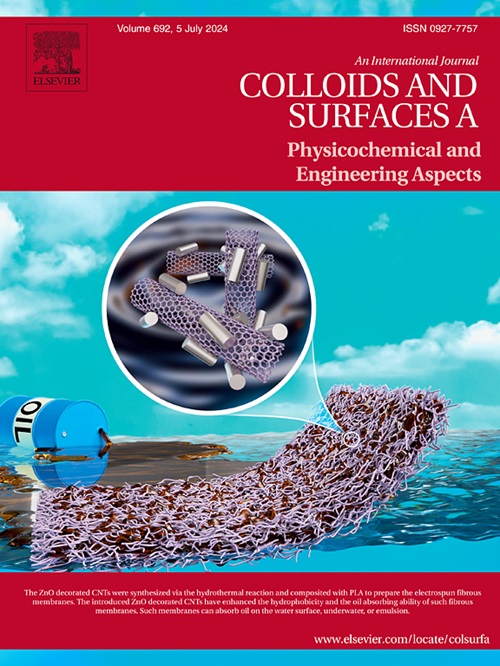通过 p-n 异质结耦合二维-Co(OH)2 小板,在层状双氢氧化物中实现缺陷和晶格定向工程化,从而增强氯霉素的光催化降解能力
IF 4.9
2区 化学
Q2 CHEMISTRY, PHYSICAL
Colloids and Surfaces A: Physicochemical and Engineering Aspects
Pub Date : 2024-10-28
DOI:10.1016/j.colsurfa.2024.135674
引用次数: 0
摘要
缺陷和界面工程在优化异质结的光催化性能方面发挥着关键作用。其中,层状双氢氧化物(LDH)因其二维片状结构和光学特性而脱颖而出。本研究的重点是通过 p-n 结构建界面电场,在二维-Co(OH)2 小板和缺陷诱导的二维-MgFe LDH 之间形成异质结,并增强氯霉素的光催化降解能力。HR-TEM 分析显示了大量的空位和晶格失向,证实了缺陷工程的有效性。通过直接共沉淀和超声波方法合成了 MgFe LDH-Co(OH)2 纳米复合材料(NCs)。MgFe LDH-Co(OH)2 的带隙为 2.05 eV,有利于可见光的吸收,在最佳条件下可在 180 分钟内显著降解 95.9 % 的氯霉素。与层状双氧化物(LDO)的对比研究表明,LDO 的功效低于 LDH。NCs 在五个周期内的稳定性和磁性显示了其在大规模废水处理应用中的潜力。此外,在光催化以及芬顿反应的帮助下,还产生了羟基自由基(-OH)和超氧自由基(O2--)。使用 ECOSAR 程序对 GC-MS 检测到的中间产物进行了毒性测试,结果表明其非常适合安全的实际应用。这项综合研究强调了缺陷工程和异质结设计在推进光催化材料用于环境修复方面的重要性,并为生产创新铺平了道路。本文章由计算机程序翻译,如有差异,请以英文原文为准。
Engineering defects and lattice disorientation in layered double hydroxides by coupling 2D-Co(OH)2 platelets via p-n heterojunction for enhanced photocatalytic degradation chloramphenicol
Defects and interface engineering play pivotal roles in optimizing the photocatalytic performance of heterojunctions. Among these, layered double hydroxides (LDH) stand out due to their two-dimensional lamellar structure and optical properties. This study focuses on creating a heterojunction between 2D-Co(OH)2 platelets and defect-induced 2D-MgFe LDH by constructing interfacial electric field via p-n junction and enhanced the photocatalytic degradation of chloramphenicol. HR-TEM analysis shows abundant vacancies and lattice disorientation, affirming the effectiveness of defect engineering. The MgFe LDH–Co(OH)2 nanocomposite (NCs) was synthesized through a straightforward co-precipitation and ultrasonic method. The band gap of 2.05 eV for MgFe LDH–Co(OH)2 facilitated visible light absorption, leading to a remarkable 95.9 % degradation of chloramphenicol within 180 min under optimal conditions. The comparison studies conducted with layered double oxides (LDO) showed its lower efficacy than LDH. The stability of the NCs over five cycles and magnetic nature showcased their potential for large-scale wastewater treatment applications. Furthermore, both hydroxyl radicals (•OH) and superoxide radicals (O2•⁻) were generated by the photocatalysis, as well as through the assistance of the Fenton reaction. The intermediates detected by GC-MS was tested for its toxicity using ECOSAR program which indicates its ideal for safe practical applications. This comprehensive study highlights the importance of defect engineering and heterojunction design in advancing photocatalytic materials for environmental remediation and paves a way for manufacturing innovation.
求助全文
通过发布文献求助,成功后即可免费获取论文全文。
去求助
来源期刊
CiteScore
8.70
自引率
9.60%
发文量
2421
审稿时长
56 days
期刊介绍:
Colloids and Surfaces A: Physicochemical and Engineering Aspects is an international journal devoted to the science underlying applications of colloids and interfacial phenomena.
The journal aims at publishing high quality research papers featuring new materials or new insights into the role of colloid and interface science in (for example) food, energy, minerals processing, pharmaceuticals or the environment.

 求助内容:
求助内容: 应助结果提醒方式:
应助结果提醒方式:


